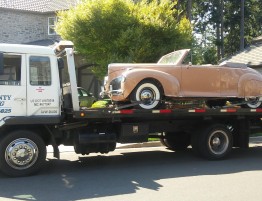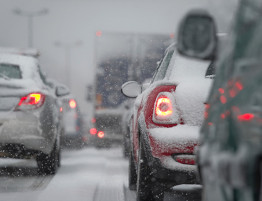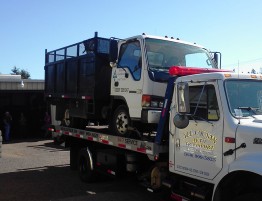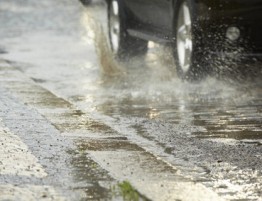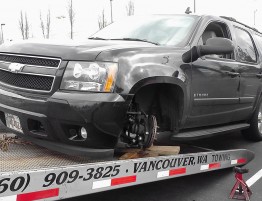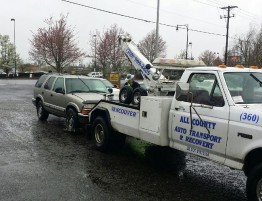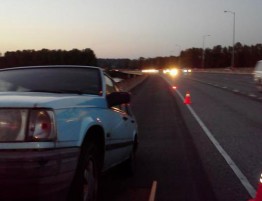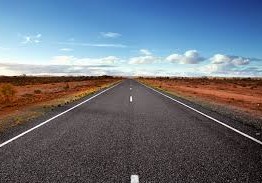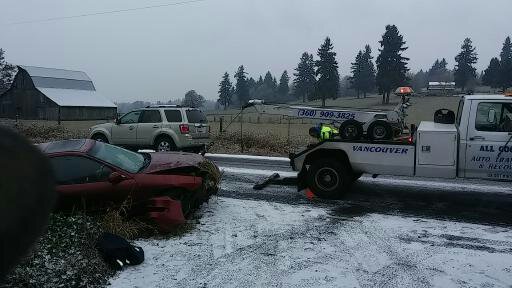
With winter here, safe driving is a must. There are a number of websites, government, private and commercial, that offer safe winter driving tips and other useful information. The info below was gathered from the following links in order to put more information in one place. So far this winter throughout the United States and other countries there have been many accidents caused by severe weather resulting in injuries as well as a number of fatalities.
The last bit of snow we received that froze and left ice on some roads for days was very treacherous. A number of people called us after they thought that they could go out and drive in it without any traction devices or traction tires. On the flat roads that is normally fine but as you all know, here in Clark County we have plenty of hills, some quite steep. We hope that you would avoid attempting to ascend or descend any ice covered hills especially if you do not have the experience or equipment to do so safely in your vehicle. There are instances where a hill can be steep enough that even with chains our trucks still cannot make the hill safely. This was the case one evening with a fellow who drove his 2 wheel drive pickup down a hill and had trouble maintaining control. Fortunately he was able to stop safely and pull his vehicle off the road. We were called by his insurance company who said that his vehicle was damaged and it needed a tow but once we arrived and spoke with the customer that was not the case. The customer was afraid to continue driving his vehicle on the fairly steep hill and wanted us to tow it home for him. The ice was solid and the hill steep enough that even with chains we would also not have enough control or traction to make the hill. Just because you have chains, cables, studded or traction tires does not mean that you will not lose control. Remember the taxi that had chains on and still ended up sliding down a steep hill into a house in the Portland area years ago? I do, and so do others who know when not to risk it.
All of us at All County Auto Towing hope that even just a little bit of this information will help keep you, your family and friends safe while on the road this winter. Just below are the links to where the info was gathered as well as our contact page and a more in depth look at what should be in a vehicle’s roadside emergency kit.
-For the OSHA information Click HERE
-For the AAA information Click HERE
-For Towing Service or Roadside Assistance Click HERE
-For Your Vehicle’s Emergency Kit Click HERE
OSHA recommends the following:
The Three P’s of Safe Winter Driving:
PREPARE for the trip; PROTECT yourself; and PREVENT crashes on the road.
PREPARE
Maintain Your Car: Check battery, tire tread, and windshield wipers, keep your windows clear, put no-freeze fluid in the washer reservoir, and check your antifreeze.
Have On Hand: flashlight, jumper cables, abrasive material (sand, kitty litter, even floor mats),shovel,snow brush and ice scraper, warning devices(like flares) and blankets. Forlong trips, add food and water, medication and cell phone.
Stopped or Stalled? Stay in your car, don’t overexert, put bright markers on antenna or windows and shine dome light, and, if you run your car, clear exhaust pipe and run it just enough to stay warm.
Plan Your Route: Allow plenty of time (check the weather and leave early if necessary), be familiar with the maps/ directions, and let others know your route and arrival time.
Practice Cold Weather Driving!
* During the daylight, rehearse maneuvers slowly on ice or snow in an empty lot.
* Steer into a skid.
* Know what your brakes will do:stomp on antilock brakes, pump on non-antilock brakes.
* Stopping distances are longer on water-covered ice and ice.
* Don’t idle for a long time with the windows up or in an enclosed space.
PROTECT YOURSELF
* Buckle up and use child safety seats properly.
* Never place a rear-facing infant seat in front of an air bag.
* Children 12 and under are much safer in the back seat.
PREVENT CRASHES
* Drugs and alcohol never mix with driving.
* Slow down and increase distances between cars.
* Keep your eyes open for pedestrians walking in the road.
* Avoid fatigue – Get plenty of rest before the trip, stop at least every three hours, and rotate drivers if possible.
* If you are planning to drink, designate a sober driver.
AAA recommends the following:
*Avoid driving while you’re fatigued. Getting the proper amount of rest before taking on winter weather tasks reduces driving risks.
*Never warm up a vehicle in an enclosed area, such as a garage.
*Make certain your tires are properly inflated.
*Never mix radial tires with other tire types.
*Keep your gas tank at least half full to avoid gas line freeze-up.
*If possible, avoid using your parking brake in cold, rainy and snowy weather.
*Do not use cruise control when driving on any slippery surface (wet, ice, sand).
*Always look and steer where you want to go.
*Use your seat belt every time you get into your vehicle.
Additional tips for long-distance winter trips:
*Watch weather reports prior to a long-distance drive or before driving in isolated areas. Delay trips when especially bad weather is expected. If you must leave, let others know your route, destination and estimated time of arrival.
*Always make sure your vehicle is in peak operating condition by having it inspected by a AAA Approved Auto Repair facility.
*Keep at least half a tank of gasoline in your vehicle at all times.
*Pack a cellular telephone with your local AAA’s telephone number, plus blankets, gloves, hats, food, water and any needed medication in your vehicle.
*If you become snow-bound, stay with your vehicle. It provides temporary shelter and makes it easier for rescuers to locate you. Don’t try to walk in a severe storm. It’s easy to lose sight of your vehicle in blowing snow and become lost.
*Don’t over exert yourself if you try to push or dig your vehicle out of the snow.
*Tie a brightly colored cloth to the antenna or place a cloth at the top of a rolled up window to signal distress. At night, keep the dome light on if possible. It only uses a small amount of electricity and will make it easier for rescuers to find you.
*Make sure the exhaust pipe is not clogged with snow, ice or mud. A blocked exhaust could cause deadly carbon monoxide gas to leak into the passenger compartment with the engine running.
*Use whatever is available to insulate your body from the cold. This could include floor mats, newspapers or paper maps.
*If possible run the engine and heater just long enough to remove the chill and to conserve gasoline.
Tips for driving in the snow:
*Accelerate and decelerate slowly. Applying the gas slowly to accelerate is the best method for regaining traction and avoiding skids. Don’t try to get moving in a hurry. And take time to slow down for a stoplight. Remember: It takes longer to slow down on icy roads.
*Drive slowly. Everything takes longer on snow-covered roads. Accelerating, stopping, turning – nothing happens as quickly as on dry pavement. *Give yourself time to maneuver by driving slowly.
*The normal dry pavement following distance of three to four seconds should be increased to eight to ten seconds. This increased margin of safety will provide the longer distance needed if you have to stop.
*Know your brakes. Whether you have antilock brakes or not, the best way to stop is threshold breaking. Keep the heel of your foot on the floor and use the ball of your foot to apply firm, steady pressure on the brake pedal.
*Don’t stop if you can avoid it. There’s a big difference in the amount of inertia it takes to start moving from a full stop versus how much it takes to get moving while still rolling. If you can slow down enough to keep rolling until a traffic light changes, do it.
*Don’t power up hills. Applying extra gas on snow-covered roads just starts your wheels spinning. Try to get a little inertia going before you reach the hill and let that inertia carry you to the top. As you reach the crest of the hill, reduce your speed and proceed down hill as slowly as possible.
*Don’t stop going up a hill. There’s nothing worse than trying to get moving up a hill on an icy road. Get some inertia going on a flat roadway before you take on the hill.
*Stay home. If you really don’t have to go out, don’t. Even if you can drive well in the snow, not everyone else can. Don’t tempt fate: If you don’t have somewhere you have to be, watch the snow from indoors.
Again, all of us at All County Auto Towing hope that you, your family and friends have a safe and fun filled winter. As good as all of this info is, it can only help if put to use. The same goes for “turn into the skid” that so many of us have heard over the years. Many of us know what to do, but when it comes down to it, those who have practiced and stay calm will be the ones who can put those thoughts into actions in a fraction of a second, because that may be all the time you have to react. Thank you for reading. Please drive safe and enjoy the road.
From Owner/Operator Steve W.
